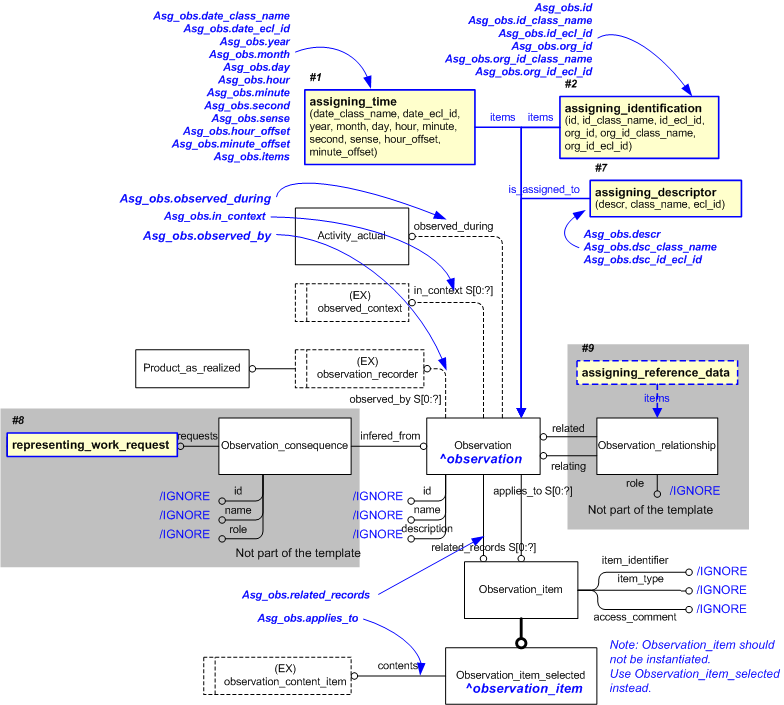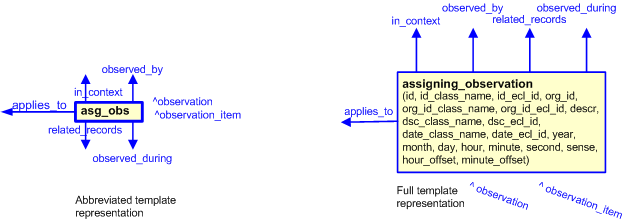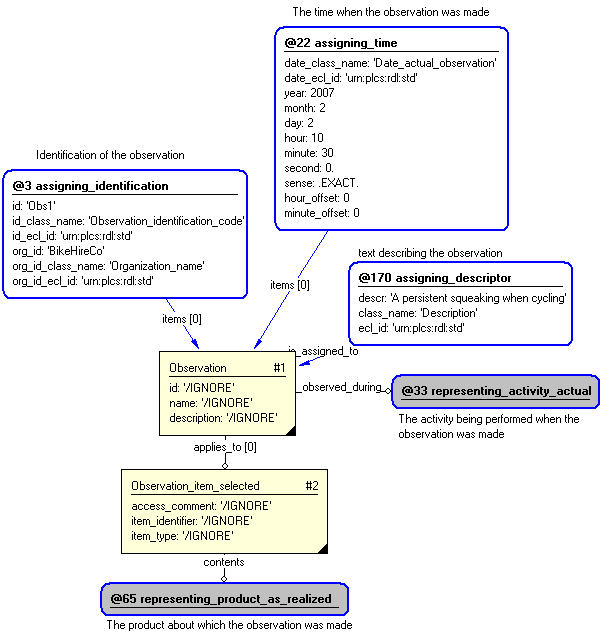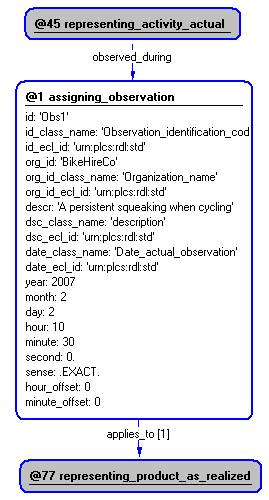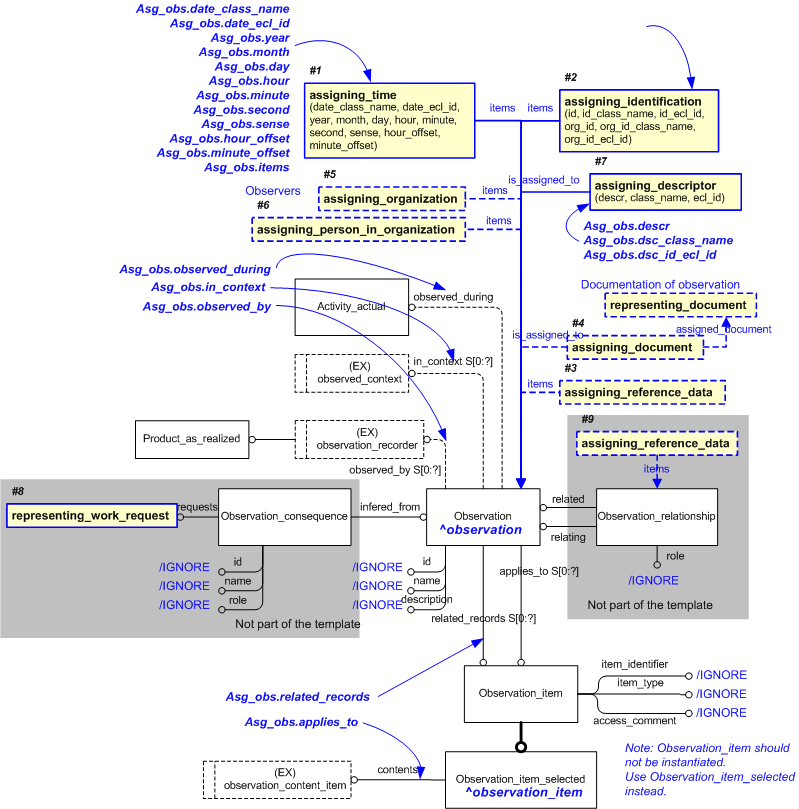| Template:— assigning_observation (asg_obs) |
Date: 2008/02/21 16:29:21
Revision: 1.19
|
This section specifies the template assigning_observation.
NOTE
An explanation of a template and the associated instantiation path is
provided in the
Template overview
section.
The EXPRESS-G diagram in
Figure
1
shows the templates and EXPRESS entities that are required
to represent the template
"assigning_observation".
The text highlighted in blue shows the template parameters.
Figure 1 — An EXPRESS-G representation of the Information model for assigning_observation
The graphic for the template to be used in other EXPRESS-G diagrams
is shown in Figure
2
below.
Figure 2 — The graphical representation of the assigning_observation template
The following input parameters are defined for this template:
The name of the class used to classify the identifier and so
provide the role or reason for the identification.
The following classes and their sub-classes can be used:
id_ecl_id (Default=urn:plcs:rdl:std,Type='URN')
The identifier of the organization that
"owns" the identifier.
The name of the class being used to classify the
identification of the organization. For example CAGE code.
The following classes and their sub-classes can be used:
The text that provides further information about the
Observation.
The name of the class used to classify the identifier and so
provide the role or reason for the identification.
The following classes and their sub-classes can be used:
The name of the class being used to classify the
role date assignment, e.g. the date when the
Observation
was made.
The following classes and their sub-classes can be used:
The year component of the date and time the observation was made.
The month component of the date and time the observation was made.
The day component of the date and time the observation was made.
The hour component of the date and time the observation was made.
The minute component of the date and time the observation was made.
This parameter is optional. If not given, it will remain unset.
The second component of the date and time the observation was made.
This parameter is optional. If not given, it will remain unset.
The direction of the offset from Coordinated Universal Time of the time the observation was made.
Enumeration values are: 'ahead', 'exact' or 'behind'.
The number of hours by which the time the observation was made is offset from Coordinated Universal Time.
The number of minutes by which the time the observation was made is offset from Coordinated Universal Time.
The value of this attribute need not be specified.
This parameter is optional. If not given, it will remain unset.
The following reference parameters are defined for this template:
Allow the
Observation
entity instantiated in this path to be referenced when this template is used.
Note: The
Observation
entity can be referenced in a template path by:
%^target = $assigning_observation.observation%
where
target
is the parameter to which the
Observation
is bound.
%^target = $assigning_observation.observation_item%
The
Observation_item entity should be
treated as an abstract entity and not instantiated. Instead use the sub type Observation_item_selected
subtype.
The following parameter combinations specify a uniqueness constraint:
Unique constraint: Observation
The instantiation path shown below specifies the entities that are to be
instantiated by the template.
Observation-- Mark the Identification_assignment entity as -- referable when this template is used by binding it to the reference -- parameter id_assgn %^observation =
Observation%
Observation.id = '/IGNORE'
Observation.name = '/IGNORE'
Observation.description = '/IGNORE'
Observation.observed_during ->
@observed_duringObservation.observed_by ->
@observed_byObservation.in_context ->
@in_contextObservation.related_records ->
@related_recordsObservation_item_selected%^observation_item =
Observation_item_selected%
Observation.applies_to ->
^observation_item
^observation_item.contents ->
@applies_to
^observation_item.item_identifier = '/IGNORE'
^observation_item.item_type = '/IGNORE'
^observation_item.access_comment = '/IGNORE'
-- Identify the Observation /
assigning_identification(
id=@id,
id_class_name=@id_class_name,
id_ecl_id=@id_ecl_id,
org_id=@org_id,
org_id_class_name=@org_id_class_name,
org_id_ecl_id=@org_id_ecl_id,
items=^observation)/
-- Assign a date to the Observation /
assigning_time(
date_class_name=@date_class_name,
date_ecl_id=@date_ecl_id,
year=@year,
month=@month,
day=@day,
hour=@hour,
minute=@minute,
second=@second,
sense=@sense,
hour_offset=@hour_offset,
minute_offset=@minute_offset,
items=^observation)/
-- Assign a description to the Observation /
assigning_descriptor(
descr=@descr,
class_name=@dsc_class_name,
ecl_id=@dsc_ecl_id,
is_assigned_to=^observation)/
The following entities are instantiated with attributes as specified:
The instance diagram in Figure
3
shows an example of the EXPRESS entities and templates that are instantiated by the template:
/assigning_observation(id='Obs1', id_class_name='Observation_identification_code', id_ecl_id='urn:plcs:rdl:std', org_id='BikeHireCo', org_id_class_name='Organization_name', org_id_ecl_id='urn:plcs:rdl:std', descr='A persistent squeaking when cycling', dsc_class_name='Decription', dsc_ecl_id='urn:plcs:rdl:std', date_class_name='Date_actual_observation', date_ecl_id='urn:plcs:rdl:std', year='2007', month='2', day='2', hour='10', minute='30', second='0', sense='EXACT', hour_offset='0', minute_offset='0')/
(an illustration of the consolidated assigning_observation template is shown in
Figure
4 below.)
Figure 3 — Entities instantiated by assigning_observation template
The instance diagram in
Figure
4
shows the graphic symbol for the template that is to be
used in other instance diagrams. The example template is:
/assigning_observation(id='Obs1', id_class_name='Observation_identification_code', id_ecl_id='urn:plcs:rdl:std', org_id='BikeHireCo', org_id_class_name='Organization_name', org_id_ecl_id='urn:plcs:rdl:std', descr='A persistent squeaking when cycling', dsc_class_name='Decription', dsc_ecl_id='urn:plcs:rdl:std', date_class_name='Date_actual_observation', date_ecl_id='urn:plcs:rdl:std', year='2007', month='2', day='2', hour='10', minute='30', second='0', sense='EXACT', hour_offset='0', minute_offset='0')/
Figure 4 — Instantiation of assigning_observation template
The following section details how the
assigning_observation
template can be optionally characterized by assigning
other constructs to it. These are characterizations commonly
applied to the template. The ISO 10303-239 EXPRESS model may enable
other assignments to the entities instantiated by the template.
The EXPRESS-G diagram in Figure
5
shows the possible characterizations of the template
"assigning_observation".
Figure 5 — Characterization of assigning_observation template
The following characterizations may apply:
Characterization Assigning reference data
NOTE this characterization is optional.
Characterization Assigning person or organization
NOTE this characterization is mandatory.
Characterization Assigning documentation
NOTE this characterization is optional.
